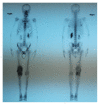Lipoma Arborescens of the Knee: Report of Three Cases and Review of the Literature
- PMID: 28243256
- PMCID: PMC5294362
- DOI: 10.1155/2017/3569512
Lipoma Arborescens of the Knee: Report of Three Cases and Review of the Literature
Abstract
Lipoma arborescens is a chronic, slow-growing, intra-articular lesion of benign nature, which is characterized by villous proliferation of the synovium, with replacement of the subsynovial connective tissue by mature fat cells. It usually involves the suprapatellar pouch of the knee joint. It is not a neoplasm but is rather considered a nonspecific reactive response to chronic synovial irritation, due to either mechanical or inflammatory insults. We report three cases of lipoma arborescens affecting the knee, the first in a young male without previous history of arthritis or trauma, the second in a 58-year-old male associated with osteoarthritis, and the final in a 44-year-old male diagnosed with psoriatic arthritis, which cover the entire pathologic spectrum of this unusual entity. We highlight the clinical findings and imaging features, by emphasizing especially the role of MRI, in the differential diagnosis of other, more complex intra-articular masses.
Conflict of interest statement
The authors declare that there is no conflict of interests regarding the publication of this paper.
Figures










References
-
- Arzimanoglu A. Bilateral arborescent lipoma of the knee. The Journal of Bone and Joint Surgery. 1957;39(4):976–979. - PubMed
Publication types
LinkOut - more resources
Full Text Sources
Other Literature Sources

